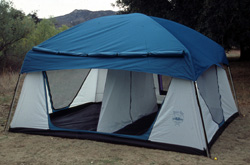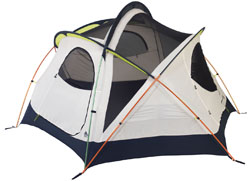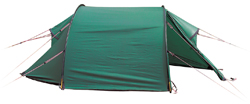Big Tents
The Paha Qué Promontory was the largest of the tents in this review. It's made to sleep up to eight adults with 120 square feet of space inside. The ceiling has a peak height of 7 feet. There are three doors, two windows, and a removable divider sheet to let campers create a veritable nylon castle with two distinct rooms.

The Paha Qué Promontory
This is the kind of tent in which you can set up cots, chairs and a large table to play cribbage late into the night under the flickering light of a lantern. Or, a large family of six or even more can sleep comfortably under one roof. For storage, the company (www.pahaque.com) includes removable gear attics, which are swaths of nylon that connect up high by the ceiling for storing clothing or lightweight camp accessories.
Despite its impressive size, the Promontory has several faults. Its boxy shape, for example, is about as non-aerodynamic as a tent design can be. Wind hits the Promontory's outside walls with a brute force that causes the nylon walls to arc inward and push against campers on the floor. The tent's awning is poorly designed, as it sags in the middle if not staked out as tight as can be.
While weight is not a huge concern for car camping, the Promontory is ridiculously large when packed up, weighing 24 pounds and taking up about a quarter of the trunk space in my car. It retails for $419, which I felt was too high for a tent with more than one significant fault.
Kelty pitches its new Pagoda as a tent that brings backpacking technology to the campground. Indeed, this big dome tent looks like an enlarged version of many small, lightweight models made for long wilderness treks, but it includes luxuries like multiple interior mesh pockets for gear stowage, two doors, a window and air-flow vents to keep things cool inside.

The Kelty Pagoda
The six-person tent has a large vestibule with about 30 square feet of space. Inside, there is about 100 square feet of space, which is enough room to comfortably sleep four or cozily sleep six. Rolled up and packed in its duffle, the Kelty tent ($400, www.kelty.com) weighs about 20 pounds.
Hilleberg's Stalon Combi tent has an interesting tunnel design, which sets up with three poles and several staked guy lines. While it is the smallest tent in the review, there is still about 50 square feet of space to fit four adults with their gear stashed away in the two zip-off vestibules.

The Hilleberg Stalon Combi
It is less than 4 feet tall, so you cannot stand up inside, but this lower profile, in addition to the curved, tunnel form factor, causes wind to flow over and around the Stalon Combi with little resistance.
Packed up, the tent weighs about 10 pounds, making it usable for canoe camping or on a backpacking trip where the tent's contents are divvied up into the packs of several hikers.
At $620, Hilleberg's (www.hilleberg.com) Stalon Combi is quite pricey. But it's a quality tent made to stand up to stiff weather while providing a roomy interior for weekend campers as well as trekkers or serious mountaineers using the tent at a high and gusty base camp.


 Subscribe to Stephen's RSS Feed
Subscribe to Stephen's RSS Feed

0 Comments:
Post a Comment
<< Home